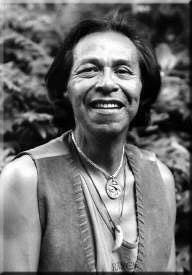
Robert’s first memories of artistic expression are musical. His
father, Wesley Hewson, and his uncle, Ray Haldane, had a band that often practiced in the
Hewsons’ home. Robert’s mother, Mary Haldane Hewson, was a singer who encouraged
all her children to sing. Robert says, “Our home was always full of music.”
Later, Robert and his brothers would have a band of their own. He can still pull an
impressive collection of harmonicas out of his carving tool kit.
|
Born in October
1946 in Metlakatla, Alaska, Robert noticed the dearth of Native visual art in that town
during his youth, “We had to go to the Trading Post in Ketchikan to see masks—or
anything—done in the Northwest style.”
Metlakatla is a unique community, founded by a group of Tsimsian families
who emigrated from Old Metlakatla, British Columbia, in 1887. They came at the urging of
William Duncan, an English missionary who worked with the Tsimsian people for many years.
He became disenchanted with the Canadian treatment of its First Peoples, so he
traveled to Washington, D.C. to negotiate a treaty and reservation for the Tsimsian in the
newly acquired territory of Alaska.
When the 900 Tsimsian moved away from Old Metlakatla to a temporary site
on the way to their new home in Alaska, Duncan told them that he had given up his old ways
to go to Alaska, and that they should do likewise. As symbols of their old ways, they
should destroy their masks and rattles, headdresses and robes. On the beach, the Tsimsian
built a huge bonfire and burned thousands of precious objects, many that had been handed
down for generations. After that there would be little public display of tribal art for
many, many years.
Robert remembers Casper Mather, a Metlakatla Tsimsian who made a living
by carving, selling mostly to tourists. “He did the roughest carving you could
imagine, but it had a power that I could feel. I wondered if I could do that
too.”
©1998 Paul Nicholson and Robert Hewson
|
